Introduction
In the current digital landscape, users access websites from a variety of devices, including desktops, tablets, and smartphones. Responsive web design ensures that your website provides a seamless experience across all these devices, enhancing user satisfaction and engagement. This guide explores why responsive web design is essential and how it can benefit your website.
What is Responsive Web Design?
Responsive web design is a design approach that ensures a website adapts seamlessly to different screen sizes and device types. Whether users are browsing on a desktop, tablet, or smartphone, the website’s layout, images, and content adjust automatically for optimal viewing and interaction.
The Importance of Responsive Design
Responsive design is crucial for several reasons:
- User Experience: A responsive website provides a consistent experience across all devices, reducing the need for users to zoom, scroll horizontally, or struggle with navigation.
- SEO Benefits: Search engines like Google prioritize mobile-friendly websites, so a responsive design can boost your search engine rankings.
- Future-Proofing: With new devices constantly being introduced, responsive design ensures your website remains accessible and functional.
How Responsive Design Works
Responsive web design relies on three key techniques: fluid grids, flexible images, and media queries.
| Technique | Description | Example |
| Fluid Grids | Uses relative units like percentages instead of fixed units like pixels to define the layout. | A webpage layout that automatically adjusts its columns and content width based on the screen size. |
| Flexible Images | Images that scale within their containing elements without breaking the layout. | An image that resizes proportionally when the browser window is resized, maintaining its aspect ratio. |
| Media Queries | CSS techniques that apply different styles based on the device’s characteristics, such as screen width. | A different navigation bar style that appears when the screen width is less than 768 pixels (mobile view). |
Benefits of Responsive Web Design
1. Improved User Experience
Responsive design enhances the user experience by ensuring your website is easy to navigate and read, regardless of the device. Users are more likely to stay on your site and return if they have a positive experience.
2. Higher Search Engine Rankings
Google and other search engines prioritize mobile-friendly websites in search results. A responsive design ensures your website meets the criteria for mobile-friendliness, potentially boosting your SEO rankings.
3. Cost-Effective
Instead of creating and maintaining separate versions of your website for desktop and mobile, a responsive design allows you to manage a single site that works on all devices, reducing development and maintenance costs.
Key Elements of Responsive Design
To create a responsive website, consider these key elements:
- Viewport Meta Tag: Ensures your website scales correctly on different devices.
- Flexible Grid Layouts: Allows your layout to adapt to different screen sizes.
- Responsive Images: Ensures images scale appropriately and do not overflow their containers.
- CSS Media Queries: Applies specific styles based on the device characteristics.
Common Challenges in Responsive Design
While responsive design offers many benefits, it also comes with challenges, such as:
- Performance Issues: Ensuring fast load times across all devices.
- Complexity: Designing a layout that works well on both large and small screens.
- Testing: Ensuring your design works across a wide range of devices and browsers.
Responsive Design Best Practices
To overcome these challenges, follow best practices like:
- Prioritizing Content: Focus on the most important content and features for mobile users.
- Testing Early and Often: Regularly test your design on different devices during the development process.
- Optimizing Images and Code: Ensure that your website loads quickly by optimizing images and minifying code.
Conclusion
Responsive web design is no longer optional; it’s essential for any website that aims to reach a broad audience. By implementing responsive design, you ensure that your site is accessible, user-friendly, and optimized for search engines, ultimately leading to better engagement and higher conversion rates. Start prioritizing responsive design today to future-proof your website and enhance your user experience.
















